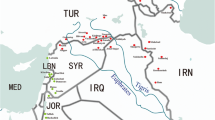Abstract
Variation at the Xgwm261 locus was studied in 92 Indian bread wheat varieties. The locus is of interest because its 192 bp allele is reported to be linked to semi-dwarfing gene Rht8. There were five allelic variants based on size. Occurrence of 165, 192 and 174 bp alleles was 44.5, 39.1 and 10.8%, respectively. Sequencing showed six new alleles. Cvs. C306 and PBW516 showed 192 bp alleles which were different from each other, different from other varieties and also from reported sequence. A 200 bp band in four varieties was unique and different in CT repeats and sequence motif next to the repeat region. Cv. NI179 showed new 198 bp allele. The varieties were also analysed with allele specific primers for Norin10 genes. Among semi-dwarf varieties, frequencies of RhtB1b and RhtD1b were 48.5 and 45.7%, respectively. The relation between alleles of Xgwm261 and agronomic traits was studied by growing plants at two locations. The 192 bp allele did not show association with grain yield or its components at Trombay location. Differences in plant height among the 192, 165 and 174 bp allele carriers were not significant at both the locations indicating that the 192 bp allele in Indian varieties was neutral with respect to plant height. Frequency of 165 bp allele was higher in varieties recommended for warmer zones and late sown conditions.
Access this article
We’re sorry, something doesn't seem to be working properly.
Please try refreshing the page. If that doesn't work, please contact support so we can address the problem.
Similar content being viewed by others

References
Ahmad, M., Sorrels, M.E. 2002. Distribution of microsatellite alleles linked to Rht8 dwarfing gene in wheat. Euphytica 123:235–240.
Calderini, D.F., Dreccer, M.F., Slafer, G.A. 1995. Genetic improvement in wheat yield and associated traits. Re-examination of previous results and latest trends. Plant Breed. 114:108–112.
Ellis, M.H., Spielmeyer, W., Gale, K.R., Rebetzke, G.J., Richards, R.A. 2002. Perfect markers for the RhtB1b and RhtD1b dwarfing genes in wheat. Theor. Appl. Genet. 105:1038–1042.
Ellis, M.H., Bonnett, D.G., Rebetzke, G.J. 2007. A 192 bp allele at the Xgwm261 locus is not always associated with Rht8 dwarfing gene in wheat. Euphytica 157:209–214.
Gale, M.D., Gregory, R. 1977. A rapid method for early generation selection of dwarf genotypes in wheat. Euphytica 26:733–738.
Gale, M.D., Youssefian, S. 1985. Dwarfing genes in wheat. In: Russel, G.E. (ed.), Progress in Plant Breeding. Vol. 1. Butterworth, London, UK, pp. 1–35.
Ganeva, G., Korzun, V., Landjeva, S., Tsenov, N., Atanastova, M. 2005. Identification, distribution and effects on agronomic traits of the semi dwarfing Rht alleles in Bulgarian common wheat cultivars. Euphytica 145:305–315.
Hedden, P. 2003. The genes of the Green Revolution. Trends in Genetics 19:5–9.
Kertesz, Z., Flintham, J.E., Gale, M.D. 1991. Effects of dwarfing genes on wheat grain yield and its components under Eastern European conditions. Cereal Res. Commun. 19:297–304.
Liu, Y., Liu, D., Zhang, H., Wang, J., Sun, J., Guo, X. 2005. Allelic variation, sequence determination and microsatellite screening at the Xgwm261 in Chinese hexaploid wheat (Triticum aestivum) varieties. Euphytica 145:103–112.
Nagarajan, S. 2002. Opportunities and strategies to make Indian wheat globally competitive. In: Rao, V.S., Singh, G., Misra, S.C. (eds), Wheat Technologies for Warmer Areas. Agharkar Research Institute, Pune, India, pp. 11–23.
Rebetzke, G.J., Richards, R.A. 2000. Gibberellic acid-insensitive wheats reduce plant height to increase kernel number and grain yield of wheat. Aust. J. Agric. Res. 51:251–265.
Roder, M.S., Korzun, V., Wendehake, K., Plaschke, J., Tixier, M.H., Leroy, P., Ganal, M.W. 1998. A microsatellite map of wheat. Genetics 149:2007–2023.
Saghai-Maroof, M.A., Soliman, K., Jorgensen, R.A., Allard, R.W. 1984. Ribosomal DNA spacer-length polymorphisms in barley: Mendelian inheritance, chromosome location and population dynamics. Proc. Natl. Acad. Sci. USA 81:8014–8018.
Sambrook, J., Fritsch, E.F., Maniatis, T. 1989. Molecular Cloning: A Laboratory Manual. Cold Spring Harbor Laboratory Press, Cold Spring Harbor, NY, USA.
Schmidt, A.L., Gale, K.R., Ellis, M.H., Giffard, P.M. 2004. Sequence variation at microsatellite locus (Xgwm261) in hexaploid wheat (Triticum aestivum) varieties. Euphytica 135:239–246.
Slafer, G.A., Satorre, E.H., Andrade, F.H. 1994. Increases in grain yield in bread wheat from breeding and associated physiological changes. In: Slafer, G.A. (ed.), Genetic Improvement of Field Crops. Marcel Dekker Ins., New York, USA, pp. 1–68.
Sourdille, P., Charmet, G., Trottet, M., Taxies, M.H., Boeuf, C., Negre, S., Barloy, D., Bernard, M. 1998. Linkage between RFLP molecular markers and the dwarfing genes RhtB1b and RhtD1b in wheat. Hereditas 128:41–46.
Worland, A.J., Law, C.N. 1985. An effect of temperature on fertility of wheat containing the dwarfing genes Rht1, Rht2 & Rht3. Annual Report Plant Breeding Institute, Cambridge, UK, pp. 69–71.
Worland, A.J., Law, C.N. 1986. Genetic analysis of chromosome 2D of wheat. The location of genes accelerating height, day length insensitivity and yellow rust resistance. Z. Pflanzenzuchtg. 96:331–345.
Worland, A.J., Law, C.N., Petrovic, S. 1988a. Pleiotropic affects of the chromosome 2D genes Ppd1, Rht8 and Yr16. In: Miller, T.E., Koebner, R.M.D. (eds), Proceedings of the Seventh International Wheat Genetics Symposium. Cambridge, UK, pp. 669–674.
Worland, A.J., Law, C.N., Petrovic, S. 1988b. Genetic analysis of chromosome 2D of wheat. II. The importance of this chromosome to Yugoslavian varieties. Plant Breed. 100:247–259.
Worland, A.J., Korzun, V., Ganal, M.W., Roder, M.S., Law, C.N. 1998. Genetic analysis of the dwarfing gene Rht8 in wheat. Part II. The distribution and adaptive significance of allelic variants at Rht8 locus of wheat as revealed by microsatellite screening. Theor. Appl. Genet. 96:1110–1120.
Worland, A.J., Sayers, E.J., Korzun, V. 2001. Allelic variation at the dwarfing gene Rht8 locus and its significance in international breeding programmes. Euphytica 119:155–159.
Zhang, X., Yang, S., Zhou, Y., Xia, X., He, Z. 2007. Distribution of the RhtB1b, RhtD1b and Rht8 reduced height genes in autumn-sown Chinese wheats detected by molecular markers. Euphytica 152:109–116.
Author information
Authors and Affiliations
Corresponding author
Additional information
Communicated by H. Bürstmayr
Rights and permissions
About this article
Cite this article
Bakshi, S., Bhagwat, S.G. Allelic Variations at Xgwm261 Locus, Sequence Determination and Agronomic Evaluation in Indian Bread Wheat Genotypes. CEREAL RESEARCH COMMUNICATIONS 40, 34–43 (2012). https://doi.org/10.1556/CRC.40.2012.1.5
Received:
Accepted:
Published:
Issue Date:
DOI: https://doi.org/10.1556/CRC.40.2012.1.5



